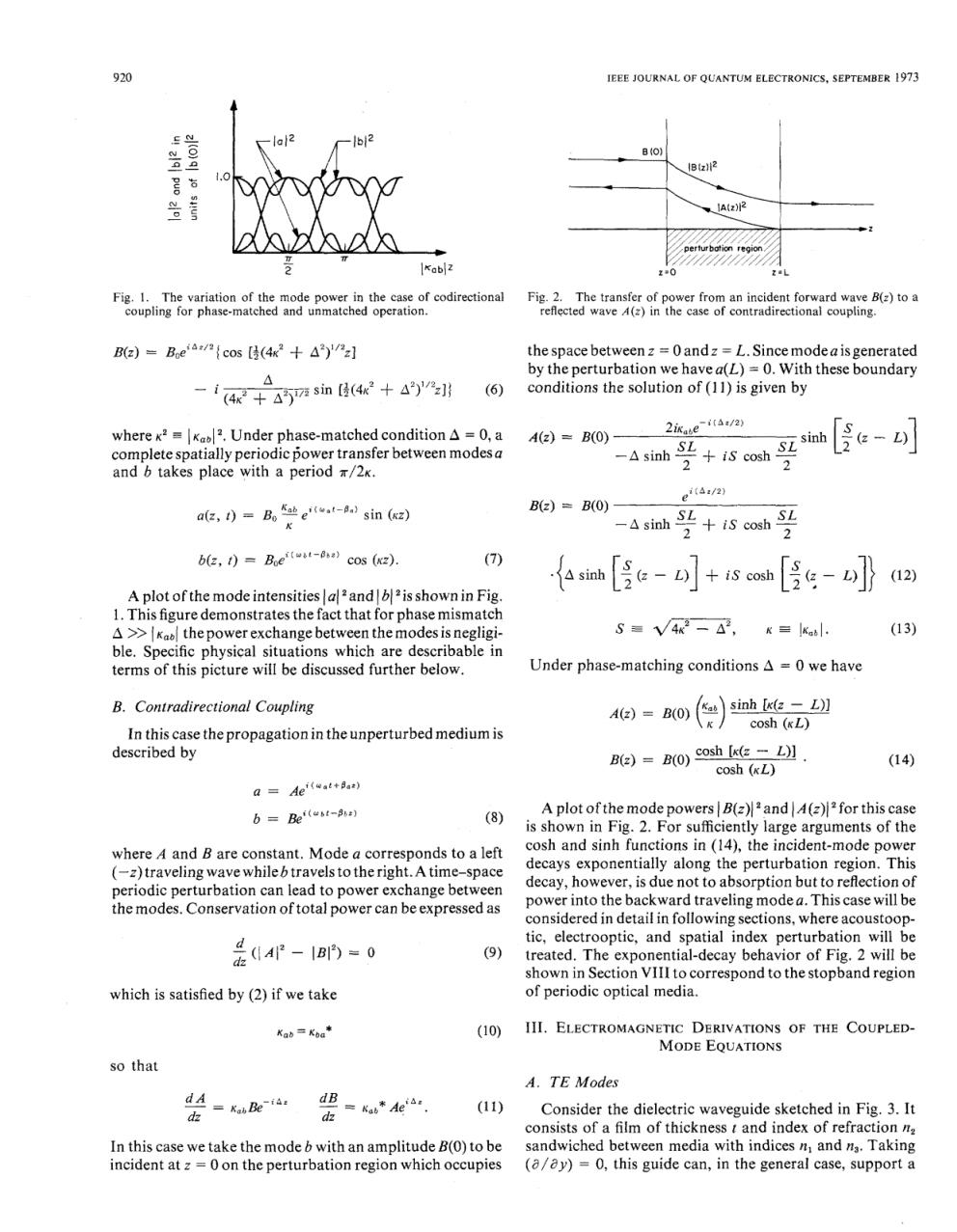正在加载图片...

920 IEEE JOURNAL OF QUANTUM ELECTRONICS,SEPTEMBER 1973 兰 (o)q 8o】 IB(z)2 IA(z)2 ertur bati 2*0 ZL Fig.I.The variation of the mode power in the case of codirectional Fig.2.The transfer of power from an incident forward wave B(z)to a coupling for phase-matched and unmatched operation. reflected wave A(z)in the case of contradirectional coupling. B(2)=Bea/2{cos[(4x2十△2)] the space betweenz=0andz=L.Sincemodeais generated by the perturbation we have a(L)=0.With these boundary △ -14+a7isin(4+△)' (6) conditions the solution of(11)is given by where k2=K2.Under phase-matched condition A =0,a A(z)=B(0) 2ike sinh -A sinh头+i5cosh SL S(-L) complete spatially periodic power transfer between modes a and b takes place with a period /2k. eita12) a(z)=Bae sin (z) B(z)=B(0) -△sinh SL+is coshS 2 b(z,1)=Boe)cos (x2). (7) {as[e-]+sco咖[g-]} (12) A plot of the mode intensities a2and b2is shown in Fig. 1.This figure demonstrates the fact that for phase mismatch A>>Ka the power exchange between the modes is negligi- 5=V4k2-△2, KKh (13) ble.Specific physical situations which are describable in terms of this picture will be discussed further below. Under phase-matching conditions A =0 we have B.Contradirectional Coupling 4(z)=B(0) sinh[w(e-L)】 cosh (KL) In this case the propagation in the unperturbed medium is described by Ba)=BO)cosh-L】 (14) cosh (KL) a Aei(wt+) b=Be(st-Bue) (8) A plot of the mode powers B(z)2and4()2for this case is shown in Fig.2.For sufficiently large arguments of the where A and B are constant.Mode a corresponds to a left cosh and sinh functions in (14),the incident-mode power (-z)traveling wave whileb travels to the right.A time-space decays exponentially along the perturbation region.This periodic perturbation can lead to power exchange between decay,however,is due not to absorption but to reflection of the modes.Conservation of total power can be expressed as power into the backward traveling mode a.This case will be considered in detail in following sections,where acoustoop- 是-a的-0 tic,electrooptic,and spatial index perturbation will be (9) treated.The exponential-decay behavior of Fig.2 will be shown in Section VIII to correspond to the stopband region which is satisfied by(2)if we take of periodic optical media. Kab=Koa (10) III.ELECTROMAGNETIC DERIVATIONS OF THE COUPLED- MODE EQUATIONS so that A.TE Modes dA dB (11) d =Kal Be-i dz =Kat*ede Consider the dielectric waveguide sketched in Fig.3.It consists of a film of thickness t and index of refraction na In this case we take the mode b with an amplitude B(0)to be sandwiched between media with indices n and na.Taking incident at z =0 on the perturbation region which occupies (a/ay)=0,this guide can,in the general case,support a920 IEEE JOURNAL OF QUANTUM ELECTRONICS, SEPTEMBER 1973 z=O 2.L Fig. 1. The variation of the mode power in the case of codirectional Fig. 2. The transfer of power from an incident forward wave B(z) to a coupling for phase-matched and unmatched operation. reflected wave A(z) in the case of contradirectional coupling. B(z) = BoeiA2/'{ cos [9(4~' + A2)'''zI the space btweenz = 0 andz = L. Sincemodeaisgenerated by the perturbation we have a(L) = 0. With these boundary A - 2 (4K + A ) sin [4(4,(' + ~')"~~z]j (6) conditions the solution of (1 1) is given by where K~ = I K=,,I 2. Under phase-matched condition A = 0, a A(Z) = B(O) SL SL complete spatially periodic Ijower transfer between modesa -A sinh - f is cosh - and b takes place with a period ir/2K. 2 2 2iK,be-i(4.2/2) sinh [f (z - L)] -i(Az/2) B(z) = B(0) - c -A sinh -- + is cosh - SL SL 2 2 b(=, t) = ~~~~(~b~-@b~) cos (KZ). (7) -{A sinh [$ (z - L)] + is cosh A plot of the mode intensities 1 a1 and 1 bJ is shown in Fig. 1. This figure demonstrates the fact that for phase mismatch A >> I K~,,[ the power exchange between the modes is negligi- s E 44K2 - A', K E ]K,bI. (1 3) ble. Specific physical situations which are describable in terms of this picture will be discussed further below. Under phase-matching conditions A = 0 we have B. Contradirectional Coupling In this case the propagation in the unperturbed medium is described by A(z) = B(0) tf) - sinh [x(z - L)] cosh (KL) cosh [K(Z - L)] cash (KL) B(z) = B(0) - (1 4) A plot of the mode powers 1 B(z)J and 1 A(z)J for this case (') is shown in Fig. 2. For sufficiently large arguments of the where A and B are constant. Mode a corresponds to a left (-z) traveling wave whileb travels to the right. A time-space periodic perturbation can lead to power exchange between the modes. Conservation of total power can be expressed as cosh and sinh functions in (14), the incident-mode power decays exponentially along the perturbation region. This decay, however, is due not to absorption but to reflection of power into the backward traveling mode a. This case will be considered in detail in following sections, where acoustoopd tic, electrooptic, and spatial index perturbation will be - (1 AI2 - IBI') = 0 dz (9) treated. The exponential-decay behavior of Fig. 2 will be shown in Section VI11 to correspond to the stopband region which is satisfied by (2) if we take of periodic ptical media. (10) 111. ELECTROMAGNETIC DERIVATIONS OF THE COUPLEDMODE EQUATIONS so that A. TE Modes - dA = K,bBe-iAz dB = K,b*Ae"z dz dz (11) Consider the dielectric waveguide sketched in Fig. 3. It consists of a film of thickness t and index of refraction nz In this case we take the mode b with an amplitude B(0) to be sandwiched between media with indices n, and n,. Taking incident at z = 0 on the perturbation region which occupies (a/ay) = 0, this guide can, in the general case, support a